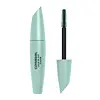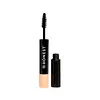Covergirl Lash Blast Clean Volume Mascara Versus Honest Beauty Extreme Volume Mascara + Bold Lash Primer
What's inside
What's inside
 Key Ingredients
Key Ingredients

 Benefits
Benefits

 Concerns
Concerns

 Ingredients Side-by-side
Ingredients Side-by-side

Water
Skin ConditioningGlyceryl Stearate
EmollientAcrylates Copolymer
Disteardimonium Hectorite
StabilisingStearic Acid
CleansingCopernicia Cerifera Cera
EmollientTriethanolamine
BufferingLecithin
EmollientPropylene Carbonate
SolventSynthetic Wax
AbrasiveEthylhexylglycerin
Skin ConditioningOleic Acid
EmollientAlcohol Denat.
AntimicrobialPhenoxyethanol
PreservativeBenzyl Alcohol
PerfumingGlycerin
HumectantPropylene Glycol
HumectantPolyethylene
AbrasiveAscorbyl Palmitate
AntioxidantPanthenol
Skin ConditioningTocopherol
AntioxidantSimethicone
EmollientGlycine Soja Oil
EmollientTrisodium EDTA
Xanthan Gum
EmulsifyingTocopheryl Acetate
AntioxidantArgania Spinosa Kernel Oil
EmollientSclerocarya Birrea Seed Oil
HumectantWater, Glyceryl Stearate, Acrylates Copolymer, Disteardimonium Hectorite, Stearic Acid, Copernicia Cerifera Cera, Triethanolamine, Lecithin, Propylene Carbonate, Synthetic Wax, Ethylhexylglycerin, Oleic Acid, Alcohol Denat., Phenoxyethanol, Benzyl Alcohol, Glycerin, Propylene Glycol, Polyethylene, Ascorbyl Palmitate, Panthenol, Tocopherol, Simethicone, Glycine Soja Oil, Trisodium EDTA, Xanthan Gum, Tocopheryl Acetate, Argania Spinosa Kernel Oil, Sclerocarya Birrea Seed Oil
Water
Skin ConditioningPolyhydroxystearic Acid
EmulsifyingCopernicia Cerifera Wax
Dioctyldodecyl Dimer Dilinoleate
EmollientGlyceryl Stearate Se
EmulsifyingPolyglyceryl-6 Distearate
EmulsifyingPolyglyceryl-10 Stearate
Skin ConditioningStearic Acid
CleansingPropanediol
SolventHydrolyzed Corn Starch
HumectantCellulose
AbsorbentSilica
AbrasiveRicinus Communis Seed Oil
MaskingGlycerin
HumectantMicrocrystalline Cellulose
AbsorbentAloe Barbadensis Leaf Juice Powder
Skin ConditioningAlgin
MaskingXanthan Gum
EmulsifyingPanthenol
Skin ConditioningCitric Acid
BufferingTrisodium Ethylenediamine Disuccinate
Hydroxyacetophenone
Antioxidant1,2-Hexanediol
Skin ConditioningCaprylyl Glycol
EmollientCI 77007
Cosmetic ColorantPullulan
Sorbitol
HumectantAcacia Senegal Gum
MaskingTrehalose
HumectantCI 77499
Cosmetic ColorantWater, Polyhydroxystearic Acid, Copernicia Cerifera Wax, Dioctyldodecyl Dimer Dilinoleate, Glyceryl Stearate Se, Polyglyceryl-6 Distearate, Polyglyceryl-10 Stearate, Stearic Acid, Propanediol, Hydrolyzed Corn Starch, Cellulose, Silica, Ricinus Communis Seed Oil, Glycerin, Microcrystalline Cellulose, Aloe Barbadensis Leaf Juice Powder, Algin, Xanthan Gum, Panthenol, Citric Acid, Trisodium Ethylenediamine Disuccinate, Hydroxyacetophenone, 1,2-Hexanediol, Caprylyl Glycol, CI 77007, Pullulan, Sorbitol, Acacia Senegal Gum, Trehalose, CI 77499
Ingredients Explained
These ingredients are found in both products.
Ingredients higher up in an ingredient list are typically present in a larger amount.
Glycerin is already naturally found in your skin. It helps moisturize and protect your skin.
A study from 2016 found glycerin to be more effective as a humectant than AHAs and hyaluronic acid.
As a humectant, it helps the skin stay hydrated by pulling moisture to your skin. The low molecular weight of glycerin allows it to pull moisture into the deeper layers of your skin.
Hydrated skin improves your skin barrier; Your skin barrier helps protect against irritants and bacteria.
Glycerin has also been found to have antimicrobial and antiviral properties. Due to these properties, glycerin is often used in wound and burn treatments.
In cosmetics, glycerin is usually derived from plants such as soybean or palm. However, it can also be sourced from animals, such as tallow or animal fat.
This ingredient is organic, colorless, odorless, and non-toxic.
Glycerin is the name for this ingredient in American English. British English uses Glycerol/Glycerine.
Learn more about GlycerinPanthenol is a common ingredient that helps hydrate and soothe the skin. It is found naturally in our skin and hair.
There are two forms of panthenol: D and L.
D-panthenol is also known as dexpanthenol. Most cosmetics use dexpanthenol or a mixture of D and L-panthenol.
Panthenol is famous due to its ability to go deeper into the skin's layers. Using this ingredient has numerous pros (and no cons):
Like hyaluronic acid, panthenol is a humectant. Humectants are able to bind and hold large amounts of water to keep skin hydrated.
This ingredient works well for wound healing. It works by increasing tissue in the wound and helps close open wounds.
Once oxidized, panthenol converts to pantothenic acid. Panthothenic acid is found in all living cells.
This ingredient is also referred to as pro-vitamin B5.
Learn more about PanthenolStearic Acid is a fatty acid. It is an emollient, emulsifier, and texture enhancer.
As an emollient, stearic acid helps soften skin. It aids the skin's protective barrier by preventing water loss. It also provides a gentle cleansing effect without stripping away natural oils.
Stearic acid may also be used to enhance the texture of products. It can add volume and stabilize ingredients such as water and oil. This can help water and oil ingredients from separating.
Sources of stearic acid include animal or vegetable fats/oils such as coconut or shea. It can be naturally found in butter, cocoa butter, shea butter, vegetable fats, and animal tallow.
This ingredient may not be Malassezia folliculitis, or fungal-acne safe.
Learn more about Stearic AcidWater. It's the most common cosmetic ingredient of all. You'll usually see it at the top of ingredient lists, meaning that it makes up the largest part of the product.
So why is it so popular? Water most often acts as a solvent - this means that it helps dissolve other ingredients into the formulation.
You'll also recognize water as that liquid we all need to stay alive. If you see this, drink a glass of water. Stay hydrated!
Learn more about WaterXanthan gum is used as a stabilizer and thickener within cosmetic products. It helps give products a sticky, thick feeling - preventing them from being too runny.
On the technical side of things, xanthan gum is a polysaccharide - a combination consisting of multiple sugar molecules bonded together.
Xanthan gum is a pretty common and great ingredient. It is a natural, non-toxic, non-irritating ingredient that is also commonly used in food products.
Learn more about Xanthan Gum